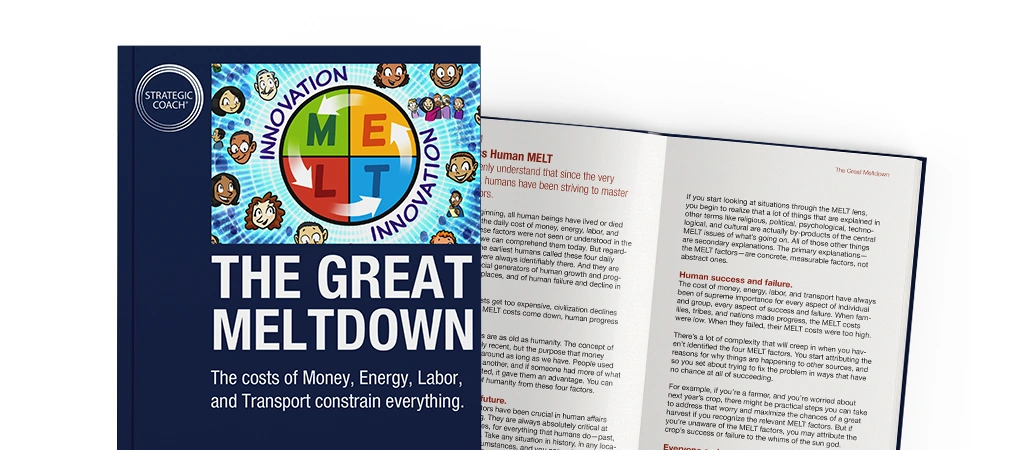How To Communicate Effectively In Everyday Life (Tools, Tips, & Tricks)
The Strategic Coach Team

Have you ever been in a situation where you tried to communicate with someone and it just didn’t work? As if the two of you were on completely different wavelengths?
It might not happen often—but when it does happen, it can be incredibly confusing, frustrating, and difficult to solve. It can hurt your relationships and bring work to a grinding halt. So, what’s the solution?
The solution is to talk about it! Everyone thinks they know how to communicate effectively, yet we all prefer to give and receive information in different ways. Talking about our communication preferences is the key to learning how to communicate effectively in everyday life—yet no one is doing it!
Sure, this stuff seems obvious. After all, everyone knows how to have a conversation. But when you need to collaborate with people, day in and day out, it’s worth taking just a few minutes to discuss how to communicate effectively with each other. You’ll be surprised at what you discover and how well you work together once you discuss this.
We all have different preferences.
We developed The Communication Builder exercise to help solve this exact problem. This is a simple tool you can use with anyone you communicate with in everyday life, either work-related or personal. The goal of this tool is to learn how to communicate effectively with each other so you can avoid confrontations and work more efficiently as a team. The best part is that it only takes a few minutes but has the potential to provide some invaluable breakthroughs.
This tool might show you that you’re already communicating effectively, or you might find out that your communication method just doesn’t jibe with your counterpart. Either way, knowing these truths will help you communicate effectively with people throughout your everyday life.
Seeing as there are so many ways to communicate with people and so many different personal preferences, it would be silly to think that your communication preferences are the same as everyone else’s. Yet that’s what virtually everyone assumes! If you like to talk on the phone, you’re going to default to a phone call with nearly everyone in your life—even if that person hates talking on the phone!
If you just look at all the different communication methods available in everyday life and the workplace—from phone calls to text, email, face-to-face conversations, video conferences and voicemails—you can easily see how choosing the right communication method for the right person will allow you to work much more effectively together.
And The Communication Builder will help you do exactly that. It’s the best way to learn how to communicate effectively in everyday life and in your business. So let’s take a look at how it works …
How to use The Communication Builder.
The Communication Builder is broken down into four simple questions:
- How do you like to give information?
- How do you prefer to receive information?
- What’s the best time to communicate with you?
- What do you need when you’re stressed or under pressure?
See? It really does take five minutes.
Filling out this exercise and seeing the answers from those around you will be one of those moments where everything clicks. Of course John in sales never responds to your voicemails—he hates voicemails! And that’s why you’ve never worked well with Mary—she exclusively communicates via email, and you hate email!
If you and the people around you can get clear on these four elements, all of a sudden, the nuances will become clear. If you thought you were already communicating effectively, you’ll become even more effective. And if you weren’t communicating effectively with someone, you’ll have a clear list of alternative methods to use with them.
Ready to put this exercise into action? Download The Communication Builder and start communicating better with everyone in your life.
1. Giving information.
This question is simple. Look at all the communication methods outlined in the exercise and get clear on what you like and don’t like. Do you prefer having a face-to-face conversation or text-based? Do you hate writing emails? Decide on which mediums of communication work best for you, and write them down.
For most people, the answers to these questions will be obvious. You also might find there are some exceptions to your “rules.” For example, some people might normally prefer phone calls but would rather send a text when they’re traveling. Feel free to get as granular as you’d like.
2. Receiving information.
You may not realize it, but sometimes the way people like to give information is different from the way they like to receive information. Try to think about how you like to receive information. Just like above, go through all the different mediums available to you and get clear on which ones you prefer and which ones you’d rather avoid.
In this question, you’ll also go a little deeper by asking yourself:
- Do I prefer the bottom line or do I want all the details?
- Do I prefer diagrams/models or would I rather have text?
You can break this down even further if necessary. Maybe you love checklists. Maybe you prefer print copies to digital. Whatever your preference is, be sure to write it down—it will only help people better understand how to communicate effectively with you.
3. Timing.
Everyone talks about “peak times” and being a “morning person” or a “night owl.” Yet no one seems to actually put that knowledge to use with those around them. By discussing this with the people in our everyday lives, we can help avoid confrontations and learn how to communicate effectively with one another.
For this question, simply ask yourself what time of day you prefer to take in information. Are you a morning person that loves getting things done before noon? Alternatively, maybe you don’t want anyone to talk to you before you’ve had your coffee.
And to take it a step further, think about what kind of timing you prefer for communication. Would you rather have someone schedule a meeting in advance or are you an “on-the-fly” type of person? These distinctions can often have a huge impact on how you work with people.
4. Dealing with pressure.
You might not think this is relevant to communication, but it’s one of the most valuable parts of this exercise. We all deal with pressure and stress in different ways, and the people around us are all affected by it.
Some people like to be left alone when they’re under pressure—they want to be able to sit down and focus on the problem at hand without any distractions. On the flip side, some people need assurance from those around them. They need people to check in on them and tell them it will all work out. Others like to have a sounding board to work through their stress.
As you can imagine, these are all massively different preferences—and mixing them up could cause some serious problems. You might be inclined to give your coworker some space when they’re stressed because that’s what you’d want—yet that’s the exact opposite of what they need! Once again, just because you’re programmed one way doesn’t mean everyone else is.
So ask yourself:
- Would you rather be alone to get on with it?
- Do you like having some company when you’re under pressure?
- Do you need reassurance?
- Do you need a sounding board?
These simple questions will prove massively helpful the next time you’re under pressure. It’s a great way to improve relationships and communicate effectively in your everyday life. Not only will you be getting the exact assistance you need, you’ll feel confident that you’re supporting people in the right ways while they’re under pressure.
What matters isn’t what you say, but the result you get.
This exercise can be used to improve communication throughout your life. Whether you’ve known someone for decades or you just met them, The Communication Builder will ensure you’re communicating with each other as effectively as possible.
And remember this one overarching communication tip: What matters isn’t what you say, but the result you get!







